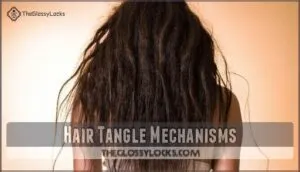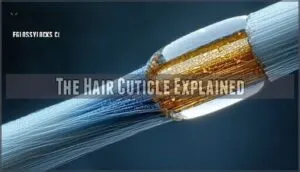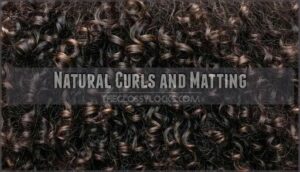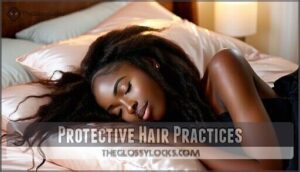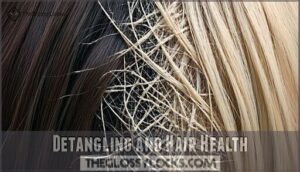This site is supported by our readers. We may earn a commission, at no cost to you, if you purchase through links.
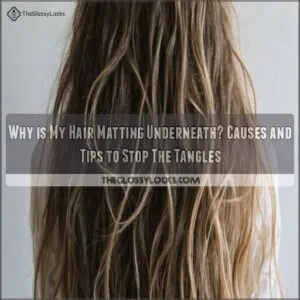 If your hair is matting underneath, it’s likely due to friction, dryness, or damage to your cuticle layer.
If your hair is matting underneath, it’s likely due to friction, dryness, or damage to your cuticle layer.
Constant rubbing against clothes or pillowcases, combined with a lack of moisture, makes strands stick like Velcro.
If you’ve got curly or textured hair, matting can be even worse since those patterns naturally knot-up.
Sleeping without a silk pillowcase or securing your hair safely can also wreak havoc.
Damaged, high-porosity hair soaks up moisture fast but loses it just as quickly, leaving tangles in its wake.
Proper conditioning and gentle detangling can help.
Curious about night routines and friction fixes? Stay tuned!
Table Of Contents
- Key Takeaways
- Hair Tangle Mechanisms
- The Hair Cuticle Explained
- Natural Curls and Matting
- Nighttime Tangling Issues
- External Tangle Triggers
- Moisture Restoration Techniques
- Protective Hair Practices
- Detangling and Hair Health
- Frequently Asked Questions (FAQs)
- Why is my hair matted?
- Why is my hair falling out?
- Why is my hair tangling and matting?
- Can a hairstyle cause matting?
- What if my hair is matted all together?
- How to prevent matted hair?
- How do I stop my hair from knotting underneath?
- Why does the underside of my hair get so damaged?
- How do I stop my hair from matting?
- Why does my hair always get matted underneath?
- Conclusion
Key Takeaways
- Your hair mats underneath because of friction from clothes or pillowcases, dryness, or cuticle damage, especially with curly or high-porosity hair.
- Sleeping on a silk or satin pillowcase and using protective hairstyles like loose braids or buns can reduce friction and prevent knots.
- Regular conditioning, applying leave-in products, and detangling in sections from ends to roots help keep hair soft and tangle-free.
- Avoid harsh treatments, over-washing, and tight hairstyles that trap loose strands to minimize matting and damage.
Hair Tangle Mechanisms
When your hair mats underneath, it’s often because strands are rubbing against each other or twisting together, creating tangles.
Damage to the hair cuticle, like rough or raised layers, makes it easier for strands to snag and cling.
Friction and Twisting
Friction and twisting are key hair matting causes, especially underneath.
When your hair moves against rough pillowcase material overnight, strands rub together and create tangles.
This problem hits harder if you’ve got natural curls or high-porosity hair since your cuticles are more likely to lift, catching other strands.
Hair movement during sleep can lead to unnatural twists that worsen matted hair.
Protective styles, like braids, can help keep curls cohesive and reduce friction.
To prevent overnight tangles, try switching to a satin or silk pillowcase to protect your hair’s smoothness and prevent knots.
Cuticle Damage
Cuticle damage is a sneaky culprit behind matted hair. When your hair cuticles—the tiny protective layers—are torn or lifted, strands lose their smoothness and snag on each other.
Cuticle damage disrupts your hair’s natural smoothness, turning once-sleek strands into tangling traps prone to mats and knots.
Chemical overload, heat styling, and environmental exposure worsen this, leaving your hair vulnerable to split ends, tangles, and breakage. High porosity intensifies these problems, as raised cuticles struggle to lie flat.
To prevent hair damage, focus on reducing harsh treatments and regularly moisturizing. Gentle detangling techniques can also help undo the knots and keep your hair softer, healthier, and tangle-free over time.
Many factors, including heat and dryness, can contribute to cuticle issues, making it essential to address these underlying causes to maintain healthy hair and prevent further damage.
The Hair Cuticle Explained
Your hair cuticles are like tiny shingles on a roof, naturally overlapping to protect the hair’s core. When healthy, these cuticle layers lie flat, preventing hair tangles by locking in moisture and creating a smooth surface.
But harsh treatments, heat styling, or high porosity can cause cuticle damage, leaving raised scales that make hair matting more likely. To avoid this, focus on nourishing care—use conditioners that aid product absorption and repair.
A healthy cuticle means less friction, fewer tangles, and softer, more manageable strands. Cool water rinsing can enhance cuticle closure, further reducing frizz.
Natural Curls and Matting
If you’ve got natural curls, they can tangle underneath because the twists and turns of the hair make it more prone to matting.
Textured hair also tends to have raised cuticles, which easily catch on each other and form knots.
High Porosity Challenges
If your hair feels like it’s always thirsty and tangling underneath, high porosity might be to blame.
Raised cuticles make moisture retention tough, leaving hair dry and prone to knots. Over-washing worsens the problem, while product buildup prevents hydration.
To tackle matted hair, focus on nourishing habits like deep conditioning regularly. Incorporate protein treatments to strengthen strands and cuticle sealing to lock in moisture.
Avoid harsh shampoos and opt for gentle, hydrating products. Consistent care keeps hair tangles at bay and helps manage high porosity hair effectively.
Textured Hair Tangles
If you’ve got textured or coily hair knots, you know how curl pattern impact can trigger frustrating tangles.
These twists and turns create the perfect setup for matted hair, especially without the right care. Luckily, there are simple tangled hair solutions to save you time and effort.
- Combat Product Buildup: Clarify regularly to keep hair texture smooth and detangling easier.
- Low Manipulation Styles: Go for protective styling tangles like twists or braids to reduce daily fuss.
- Wrap It Up: Use a silk scarf or pillowcase to shield curls from nighttime frizz and matting.
Proper care keeps textured hair strong and matting-free!
Nighttime Tangling Issues
When you sleep, nighttime friction from your head rubbing against the pillow can cause knots and tangles, especially underneath your hair.
Without proper care, this can lead to matted hair by morning. Thankfully, a few simple adjustments can save the day—or night!
- Switch to Silk or Satin Pillowcases: These smooth surfaces reduce friction and help maintain moisture retention, unlike drying cotton fabrics.
- Use Protective Hairstyles: Loosely braid, twist, or bun your hair to limit movement and tangling overnight.
- Invest in Satin Bonnets or Scarves: These keep your hair contained, preventing matting and protecting delicate strands.
A thoughtful nighttime hair care routine isn’t optional. It’s essential for preventing matted hair underneath and ensuring you wake up with manageable, healthy locks!
Consider that high porosity hair is especially prone to tangling.
External Tangle Triggers
Ever wonder why matted hair underneath seems unavoidable some days?
It’s often about what you wear and how it interacts with your hair. Fabrics like wool and cotton create friction, roughening the hair cuticles and increasing tangling.
Jewelry plays a sneaky role, too—necklace clasps and earring backs catch strands and twist them into knots while you move.
Weather effects like wind can add to the chaos, tangling hair you thought was under control.
Plus, tight hairstyles combined with pillow friction at night might leave you battling matted hair by morning. Even hard water and product buildup don’t help, making strands rough and prone to matting.
Avoid abrasive materials and snagging accessories to keep hair smooth and tangle-free.
Moisture Restoration Techniques
Restoring moisture to your hair is key to reducing matting and keeping it smooth.
Using a good conditioner and rinsing with cool water helps lock in hydration, making your hair easier to manage.
Conditioner Application
When your hair tangles underneath, conditioner can be your best friend. The right application methods make all the difference in taming knots and keeping strands smooth.
Use a quarter-sized amount of a creamy conditioner like Maui Moisture Hibiscus Coconut. Start mid-length and work gently down to the ends, avoiding scalp application to prevent product buildup. Let it sit for about two minutes before rinsing thoroughly.
Many consumers are now buying creamy hair products.
- Opt for conditioners with slip to ease detangling, especially for matted hair.
- Apply conditioner every wash to boost moisture and manageability.
- Comb through strands with your fingers to guarantee even coverage.
Cool Water Rinsing
After conditioning, rinsing with cool water is a simple but effective way to improve your hair’s health.
Cool water helps with cuticle sealing, locking in moisture and reducing frizz. This smoothes the strands, making hair detangling easier while boosting shine enhancement.
Plus, it aids in residue removal, leaving your hair fresh and light. Cool water also stimulates the scalp, encouraging circulation for healthier roots.
For anyone dealing with matted hair, this quick step is a game changer. Adding this to your hair care tips guarantees better moisture retention and reduces pesky tangles underneath.
It’s a must-try solution, providing better moisture retention and healthier roots.
Protective Hair Practices
Protective hair practices can make a big difference in stopping matting and tangles.
Using a silk pillowcase and securing your hair safely at night helps reduce friction and keeps your strands smooth.
Silk Pillowcase Benefits
Switching to a silk pillowcase is a small change with big benefits for your hair and skin.
A silk pillowcase transforms your sleep routine, reducing friction, preventing tangles, and leaving hair smooth, hydrated, and bedhead-free.
Its smooth surface reduces friction, helping to minimize tangles, matting, and hair breakage while you sleep. Silk also retains moisture, leaving hair and skin hydrated. Plus, it prevents bedhead by keeping strands in place overnight.
Many users also report experiencing noticeable skin improvements.
- Friction reduction prevents knots and tangles.
- Moisture retention keeps hair soft and less prone to dryness.
- Hair smoothness reduces morning frizz.
- Bedhead prevention guarantees easier styling each day.
Safe Hair Gathering
To prevent knotted hair and keep matting at bay, try gathering your hair into gentle ponytails, loose buns, or secure braiding before bed.
These styles reduce friction and keep strands aligned, making detangling easier the next day.
For added protection, swap harsh elastics for soft headbands or fabric ties to avoid breakage.
Wrapping your hair in a satin scarf also locks in moisture and minimizes tangling overnight.
These simple yet effective hair care habits are essential for tangling prevention and keeping your locks healthy and manageable.
Detangling and Hair Health
Proper detangling is key to keeping your hair healthy and preventing pesky mats. Using the right tools and trimming regularly helps minimize damage and keeps your strands smooth.
Brushing and Combing
Detangling doesn’t have to feel overwhelming when you’ve got the right hair brushing techniques. Start by using a wide-toothed comb or soft bristle brush for gentle detangling.
Wet brushing works best on conditioned hair to reduce stress on your strands. Always section your hair into smaller parts—it’s easier to tackle tangles this way.
Brush from the ends upwards to prevent unnecessary breakage. And don’t forget: combing frequency is key. Daily brushing redistributes oils, leaving hair shinier and healthier.
Using a quality hair detangler can make the process smooth and pain-free! Regular brushing can stimulate blood circulation in the scalp.
Regular Trims
Your brush and comb can only do so much, so don’t skip regular trims in your hair care routine.
Split end removal through preventative trimming keeps damage from creeping up the hair shaft, reducing tangles and matting. These small snips also aid shape maintenance, keeping your style looking fresh.
Using the right hair cutting shears is important for clean, effective trims. Think of trims as damage control—a simple way to keep hair tangling and matting at bay.
Plus, regular cuts can improve hair growth impact, so you’re not just cutting off, but growing better hair.
Frequently Asked Questions (FAQs)
Why is my hair matted?
Ever wonder why your hair mats so easily?
It happens when dryness, improper detangling, or rough handling cause strands to tangle and twist.
Neglect nighttime care or proper moisturization, and knots can quickly take over.
Why is my hair falling out?
Your hair may be falling out due to stress, hormonal changes, or nutritional deficiencies.
Overstyling, harsh chemicals, and certain medical conditions can also trigger shedding.
Check with a doctor if it feels excessive or unusual.
Why is my hair tangling and matting?
Did you know curly hair is 30% more prone to tangling?
Your hair might be matting due to dryness, improper detangling, or friction from fabrics.
Moisturize regularly, use satin pillowcases, and detangle gently!
Can a hairstyle cause matting?
Yes, certain hairstyles can cause matting, especially tight ones like braids or ponytails that trap loose hairs.
Frequent friction or neglecting detangling makes it worse.
Opt for looser styles and detangle regularly to avoid this, ensuring a hairstyle that does not lead to friction.
What if my hair is matted all together?
Imagine your hair as a tangled forest.
If it’s matted together, saturate the knots with conditioner or detangling spray, gently loosen strands with a wide-tooth comb.
Work from the ends upward carefully.
How to prevent matted hair?
Detangle your hair regularly, use leave-in conditioner and oils for moisture, and sleep on a satin pillowcase or with a silk scarf.
Avoid harsh products, over-washing, and excessive heat to keep tangles at bay, using leave-in conditioner can be particularly helpful.
How do I stop my hair from knotting underneath?
Did you know tangled hair can cause up to 75% more breakage?
Prevent knots underneath by brushing daily, using leave-in conditioner, and sleeping on satin.
Tying hair loosely at night also works wonders!
Why does the underside of my hair get so damaged?
The underside of your hair takes on extra damage because it rubs against clothing and pillows, creating friction.
Combine that with moisture loss, poor detangling, or neglect, and it’s a recipe for dryness and breakage.
How do I stop my hair from matting?
Taming matted hair feels like solving a puzzle, but it’s simple.
Keep it moisturized with conditioner and oils, sleep on satin, brush daily, and detangle gently in sections.
Avoid harsh products or over-styling.
Why does my hair always get matted underneath?
Your hair mats underneath due to friction from your clothes, lack of brushing, or improper detangling.
Dryness, high porosity, and not moisturizing also play a role.
Satin scarves or regular detangling help prevent this, with satin scarves being a particularly useful tool.
Conclusion
Think of your hair like a delicate fabric—it needs the right care to stay smooth and tangle-free.
If you’re wondering, “why is my hair matting underneath,” it’s often due to friction, dryness, or damage.
Using a silk pillowcase, moisturizing regularly, and gently detangling can protect your strands.
Keep your hair hydrated with proper conditioning and avoid rough brushing to address these triggers, and you’ll reduce matting, making your hair easier to manage and healthier over time.

